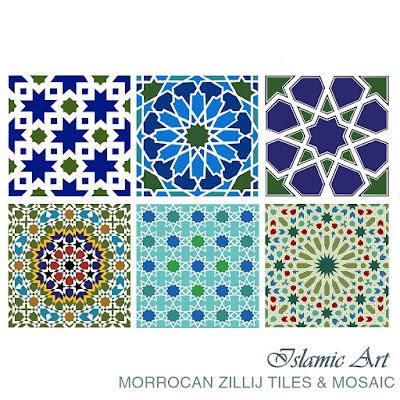ISLAMIC ART: Evolution & Styles
The inspiration behind Islamic Designs and development of Islamic Themes and Patterns across different regions
Arab Influence
 |
| Old Arabic Language Calligraphic Piece |
Arab element is probably one of the most clearly prominent ones in this form of art. Being the language of the Islamic Holy Book Quran and the native language of earliest Muslim majority this culture it played an important role in the development of Islamic Art and was incorporated into design in several forms, calligraphy being the most notable.
 |
| Construction of girih pattern in Darb-e Imam spandrel |
Naturally, this interest was reflected in the Art as well; to such an extent that studies today prove that Arab designs used modern advanced geometry concepts in medieval times that were not known to the rest of the world till many centuries later.
Turkish Influence
 |
| Museum of Turkish and Islamic Art (Ibrahim Pasha Palace) |
 |
| Handpainted Iznik Ceramic Tiles from the 16th Century |
Persian Influence
This element is not easily definable. One remarkable innovation of the Persians was placing a dome over a square room using squinches. |
| Sheikh Lotfallah Mosque, Isfahan, Iran. |
 | ||
| Persian Rug |
Not Defined or Contained by Geographical Boundaries
Yes, the above three major elements are clearly recognizable and each has contributed a lot in terms of inspiration and development of Islamic Art. However, over several periods they were so closely integrated and intermingled that the elements can hardly be distinguished at separate styles anymore. This cultural melting pot phenomenon is not unparalleled and is often seen when one aspect (in this case religion) brings people from different cultures and backgrounds together. It eventually results into formation of a single theme that has a little something from every culture but overall it’s perceived as one unified culture. Islamic Art is an example of the result of a feature that no longer is bound by ethnicity, geography or reigns.Religious Influence
Out of all elements in Islamic Art the most undeniably significant is; religion. Art is said to be a reflection of a culture and its perspective of the world. This applies perfectly to Islamic Art, as the art mirrors the cultural values of Muslims and their view of life, universe and the Oneness of God.
This piece is a part of our Islamic Art Blog Series. More articles on subjects like "Moroccan Zelig art", "Islamic Mosaics" and "materials and mediums most popular in Islamic Art" are coming up soon. Read the introductory piece on Islamic Art here.





